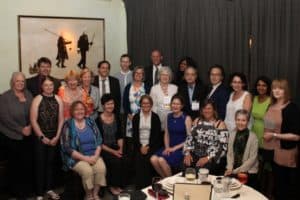by Lindsey J. Wimmer, RN, MSN, PHN, CPNP, CPLC
I wasn’t going to write a blog this month because I felt like there were so many wonderful things that happened at the Stillbirth Summit – I can’t possibly do it all justice. But we have received many comments and suggestions that have prompted me to talk about what the Summit means and does in a much larger sense.
So what did we learn from the Stillbirth Summit?? We will be addressing many of the presentations in the future. And participant questions that weren’t able to be asked during the sessions will be featured in our Ask the Experts section of our newsletter. So I don’t want to talk about the medical issues. The major points I learned are highlighted by the unique characteristics of this meeting.
At the most basic level, the Stillbirth Summit is a 3-day educational conference where health professionals can learn about emerging research in stillbirth prevention and care.
There are several things that are different about this meeting though.
Parents and advocates are invited to attend. This is extremely rare for health conferences because most people assume the public can’t understand most of what is said, will be too emotionally attached to the issues to learn or contribute, and it will inhibit the health professionals from having professional and honest discussions.
What we have found is that the families who attend have done their homework! They may not understand all of what is discussed, but they have done enough of their own research to follow along and learn. They don’t have to understand every study to be inspired by the work being done.
Many parents are emotionally involved in the subject matter. But so are many of the health professionals. I hope we ALL are to some degree because that passion and empathy is what leads progress. Emotions are not a bad thing and they do not interfere in the overall goals. I would argue that they improve the outcomes because it reminds us that what we’re doing impacts real families.
After the first Stillbirth Summit in 2011, I was most worried about the health professionals feeling like the non-medical attendees limited the value of the conference. To the contrary, they immediately offered that having the parents there provided insight that is otherwise impossible to achieve. Without putting words in their mouths, I think it is gratifying for them to know that people impacted by their work appreciate their efforts and want to support them in many ways. We heard similar comments after the second Summit in 2014, and this year was no different.
The Stillbirth Summit utilizes a round-table format. This format is used in many industries, but can be confusing to those not familiar with it. The idea is that the presenters are speaking to each other and the rest of us get to be observers. The final session is devoted to discussion amongst the presenters. In this situation, the goal is for them to enhance their own work given what they have learned from each other and create collaborations for new work. The attendees provide essential support and guidance through this process. We hear from several researchers that this is their favorite conference to attend because of this session. They rarely have the time and opportunity to gather so many brilliant minds with similar goals together for this purpose. I am very encouraged by the dialogue that occurred this year and expect to see many studies and papers in years to come that have their roots in this meeting.
In this sense, the meeting is just the beginning. We have learning objectives for each presentation just like all medical conferences. But the bigger goals are to push stillbirth prevention and care forward.
Collaboration is encouraged. It can be very overwhelming to see all the issues that contribute to pregnancy loss and infant death. It is much more manageable, however, when we are able to see people who are each working on their piece of the puzzle. Even more inspiring is their desire to work together so that the puzzle will be a beautiful picture someday. For this, we have to give credit to the researchers. It is common for this work to be protected and held very close. This is understandable because it is their intellectual property and the sum of their professional efforts. However, we are grateful for the individuals who embrace the philosophy of the Stillbirth Summit and share their work, goals, and challenges for sake of the greater good. They all learn from each other which improves their work moving forward and benefits babies and families everywhere. We are so blessed to have professionals who keep the babies as their primary focus.
Finally – The word “stillbirth” is in the title. This may seem obvious and not that exciting. And it wasn’t a big deal to me when we first used it. I’ve come to learn the significance though. Many of the presentations talked about or alluded to the stigma, misunderstanding, and lack of awareness that surrounds these losses. It is a barrier to progress in both prevention and care. By simply having the word in the title, it may help create some awareness. One great example is the number of hotel guests who stopped by the registration desk to ask what stillbirth is or to share their own connection to stillbirth.
As much as that might do for awareness, it does the opposite for attracting health professionals. For many years, I was very frustrated with my colleagues in obstetrics for not attending this conference and being as passionate about stillbirth prevention as I am. I assumed that every health professional wanted to learn and do all he/she could to prevent any poor outcomes. I expected them to all have a scientific curiosity that has prompted advancement in so many areas of medicine. I interpreted their avoidance as a lack of empathy and desire to improve.

I have since come to realize that my interpretation was flawed. It was pointed out to me that their avoidance may have more to do with fear and self-doubt. In our society, we expect our physicians to have all the answers. When they are unable to provide families with answers to such tragic circumstances, they feel helpless. They may see a poor pregnancy outcome as their personal failure, even if they did everything as they have been taught. Additionally, poor outcomes, and stillbirth in particular, often creates fear for the providers that the family will blame them. This may have personal, professional, and even legal or financial implications.
Knowing this, I have even more appreciation for the health professionals who are willing to take time away from work and family to be part of this conference. It takes courage to acknowledge that we can do better and that they can be part of the solution. It also takes strength to talk about our “failures”.
I want the health professionals to know that families do not see these losses as your personal failure. Failure to us comes when health professionals shrug their shoulders, act like a baby dying is just another day at the office, tell us that these things just happen, or put their heads in the sand to avoid the topic. Anytime we see a health professional upset by a poor outcome, struggling to understand, or working to improve – we are inspired. That gives us hope. It tells us that our babies do have an impact on this world and that they matter. We don’t expect health professionals to have all the answers, but we do expect them to ask questions with us when we don’t have answers.
So – to all of the physicians, midwives, nurse practitioners, nurses, social workers, clergy, epidemiologists, counselors, and many more who attended – THANK YOU – from all of us. Thank you for seeing the big picture and working WITH us to improve stillbirth prevention and care.
STILLBIRTH SUMMIT 2019!
JUNE 19-21, 2019

Add your first comment to this post